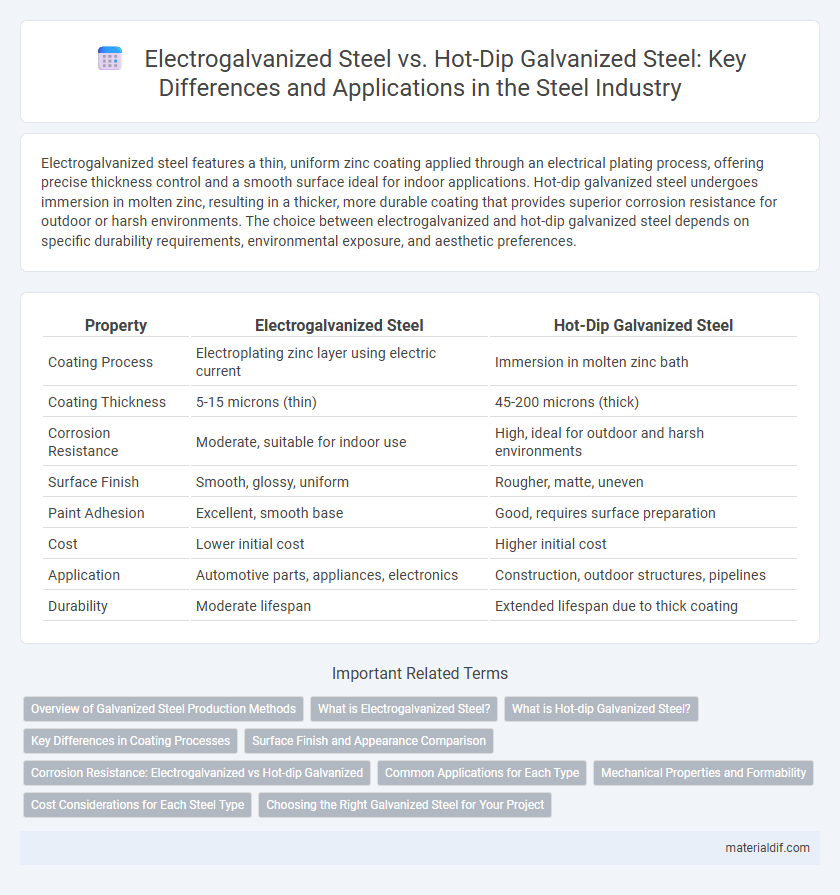Electrogalvanized steel features a thin, uniform zinc coating applied through an electrical plating process, offering precise thickness control and a smooth surface ideal for indoor applications. Hot-dip galvanized steel undergoes immersion in molten zinc, resulting in a thicker, more durable coating that provides superior corrosion resistance for outdoor or harsh environments. The choice between electrogalvanized and hot-dip galvanized steel depends on specific durability requirements, environmental exposure, and aesthetic preferences.
Table of Comparison
| Property | Electrogalvanized Steel | Hot-Dip Galvanized Steel |
|---|---|---|
| Coating Process | Electroplating zinc layer using electric current | Immersion in molten zinc bath |
| Coating Thickness | 5-15 microns (thin) | 45-200 microns (thick) |
| Corrosion Resistance | Moderate, suitable for indoor use | High, ideal for outdoor and harsh environments |
| Surface Finish | Smooth, glossy, uniform | Rougher, matte, uneven |
| Paint Adhesion | Excellent, smooth base | Good, requires surface preparation |
| Cost | Lower initial cost | Higher initial cost |
| Application | Automotive parts, appliances, electronics | Construction, outdoor structures, pipelines |
| Durability | Moderate lifespan | Extended lifespan due to thick coating |
Overview of Galvanized Steel Production Methods
Electrogalvanized steel is produced by applying a thin layer of zinc onto the steel surface using an electroplating process, resulting in a smooth finish with precise coating thickness control, ideal for automotive and appliance applications. Hot-dip galvanized steel involves immersing the steel in molten zinc, creating a thicker, more durable zinc layer that provides superior corrosion resistance, commonly used in construction and outdoor environments. Both methods enhance steel's longevity by protecting against rust, but differ significantly in coating thickness, durability, and surface characteristics.
What is Electrogalvanized Steel?
Electrogalvanized steel is a type of steel coated with a thin layer of zinc through an electroplating process, providing a uniform and smooth finish that enhances corrosion resistance. This method allows precise control of the zinc coating thickness, typically thinner than hot-dip galvanized steel, making it ideal for applications where appearance and tight dimensional tolerances are essential, such as automotive and appliance manufacturing. The electrogalvanized coating adheres well to the steel surface, offering moderate protection against rust while allowing for better paint adhesion compared to hot-dip galvanized alternatives.
What is Hot-dip Galvanized Steel?
Hot-dip galvanized steel is produced by immersing steel into molten zinc, creating a thick, durable coating that offers superior corrosion resistance compared to other methods. This process results in a metallurgical bond between steel and zinc, ensuring long-lasting protection against rust and environmental damage. Its robust coating makes it ideal for outdoor structures, automotive parts, and construction materials exposed to harsh weather conditions.
Key Differences in Coating Processes
Electrogalvanized steel undergoes an electrolytic deposition process where a thin layer of zinc is uniformly applied through electric current, resulting in a smooth, precise coating ideal for indoor applications. Hot-dip galvanized steel involves immersing the steel in molten zinc, creating a thicker, more durable coating that provides superior corrosion resistance suitable for outdoor and industrial environments. The fundamental difference lies in coating thickness and adhesion, with electrogalvanizing offering a finer finish and hot-dip galvanizing delivering enhanced protection against harsh elements.
Surface Finish and Appearance Comparison
Electrogalvanized steel features a smooth, uniform surface with a bright, shiny finish ideal for aesthetic applications requiring precise coating thickness. Hot-dip galvanized steel displays a thicker, more textured surface with a duller, matte appearance caused by the zinc coating's crystallization during the dipping process. The choice between the two depends on the desired balance between corrosion resistance and visual appeal in steel products.
Corrosion Resistance: Electrogalvanized vs Hot-dip Galvanized
Electrogalvanized steel offers a thin, uniform zinc coating that provides moderate corrosion resistance, making it suitable for indoor applications or environments with minimal exposure to moisture. Hot-dip galvanized steel features a thicker, more robust zinc layer that bonds metallurgically with the steel, delivering superior protection against rust and corrosion in harsh outdoor and industrial environments. The enhanced durability of hot-dip galvanization ensures longer service life and better resistance to abrasion and weathering compared to electrogalvanized steel.
Common Applications for Each Type
Electrogalvanized steel is commonly used in automotive components, household appliances, and electronic enclosures due to its smooth finish and corrosion resistance suitable for indoor environments. Hot-dip galvanized steel is widely applied in construction, infrastructure projects, and outdoor equipment where superior durability and protection against harsh weather conditions are critical. Both types serve distinct purposes, with electrogalvanizing favored for precision and appearance, while hot-dip galvanizing excels in heavy-duty, long-lasting protection.
Mechanical Properties and Formability
Electrogalvanized steel exhibits a smoother, more uniform coating with excellent formability, enabling precise bending and shaping without cracking. Hot-dip galvanized steel offers superior mechanical strength and enhanced corrosion resistance due to its thicker zinc layer but may experience reduced formability and increased brittleness in complex forming processes. Selecting between these coatings depends on balancing the need for mechanical durability with specific fabrication requirements and surface finish quality.
Cost Considerations for Each Steel Type
Electrogalvanized steel typically has a lower initial cost due to its thinner zinc coating and automated production, making it suitable for applications requiring moderate corrosion resistance and precise thickness control. Hot-dip galvanized steel involves higher upfront costs because of the thicker, more durable zinc layer applied through immersion, providing superior long-term protection against corrosion in harsh environments. When balancing cost and durability, electrogalvanized steel is preferred for indoor or less aggressive settings, whereas hot-dip galvanized steel offers better value for outdoor or highly corrosive conditions despite the greater initial investment.
Choosing the Right Galvanized Steel for Your Project
Electrogalvanized steel features a thin, uniform zinc coating ideal for indoor applications and automotive parts due to its smooth finish and precise dimensions. Hot-dip galvanized steel provides a thicker, more durable zinc layer suited for outdoor and heavy-duty environments, offering superior corrosion resistance and longevity. Selecting the appropriate galvanized steel depends on project-specific factors such as exposure conditions, required durability, and surface finish preferences.
Electrogalvanized steel vs Hot-dip galvanized steel Infographic

 materialdif.com
materialdif.com